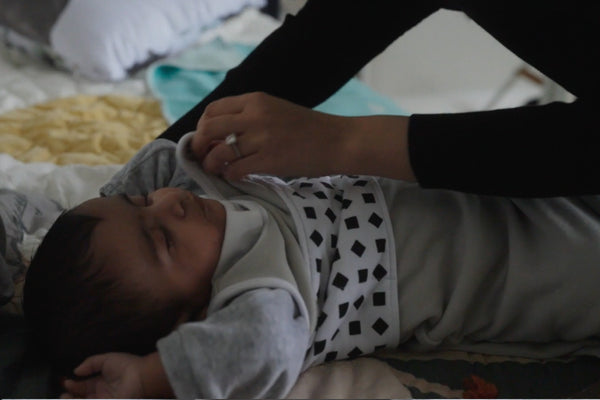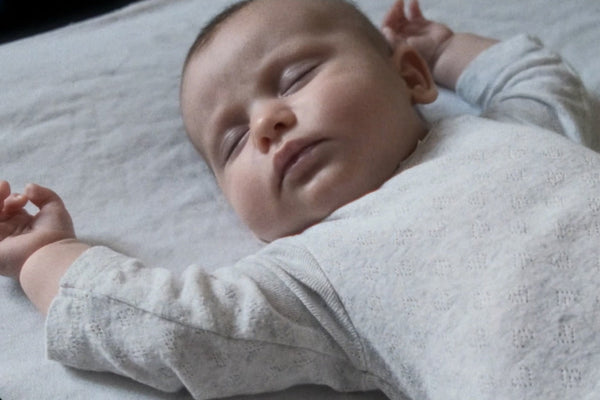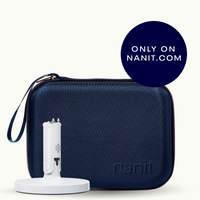With the winter months closing in, of course, you want to know how to keep babies warm at night.
After all, your baby getting a good, comfortable night’s rest works all kinds of magic: Baby sleep plays a key role in everything from creating memories to building emotional regulation. But if you’re worried about the nursery being too cold, piling your infant in layer after layer may lead to overheating, fussiness—and potential danger.
Luckily, the best safe sleeping practices, coupled with quality products, can give your little one the peaceful rest they need. Here are some ways to keep your baby warm in winter (and year-round).
Understanding baby’s sleep environment
Creating and maintaining an ideal sleep space for your baby is key to their comfort and safety. Not only can it curb the risk of Sudden Infant Death Syndrome (SIDS), but it may also promote fewer nap and night-time disturbances.
But what does an “ideal” sleep space look like, exactly?
The American Academy of Pediatrics (AAP) has a few important recommendations:
- Position. Place your baby on their back to sleep: The National Institutes of Health (NIH) says this is the safest sleeping position for all babies, even preemies and those who have reflux. Once they start to roll over on their own, it’s fine for them to stay on their belly—but always begin by placing them in the crib on their back.
- Surface. The AAP also suggests that babies should sleep on a firm, flat mattress in either a crib, bassinet, or portable play yard.
- Bedding. Few things are cuter than comforters covered in animal prints. That said, soft, squishy bedding (and too much of it) can be a health hazard for your infant. Rather than using blankets, consider dressing your baby in appropriate sleep wear for warmth (see more on that below). Also, use a fitted crib sheet and keep your baby’s sleep surface free of stuffed animals, pillows, loose blankets, and bumpers.
- Room Temperature. You might be tempted to bundle up your baby and dial up the heater the minute the mercury drops. But pediatric experts say that the best sleeping temperature for infants hovers between 68 and 72 degrees Fahrenheit. Nanit’s Pro Baby Monitor can help maintain this optimal environment, as it tracks temperature and humidity levels in your baby's room. If your baby’s nursery or sleep space temperature dips below 68, adding an additional layer of clothing may help keep them cozy. Check out ideas for that below!
Introducing Nanit Baby Sleep and Breathing Wear
The room environment absolutely plays a role in how well your baby sleeps. Your baby’s sleepwear is an important part of the picture, too.
Here’s what to consider when it comes to sleep wear:
The TOG on the garment(s) and/or bedding you’re eyeing. TOG refers to the thermal overall grade or the amount of warmth a textile offers. The higher the rating, the warmer the garment will be. For example, heavier sleep wear designed for the winter months generally has a TOG rating of 2.5 (and shouldn’t exceed 4). Meanwhile, summery materials, like cotton and muslin, have a TOG between 0.5 and 1.
The TOG value that’s best for your baby depends on how warm or cool you keep your baby’s room.
Here’s how to dress a newborn for sleep in winter:
- Sleep swaddle. Swaddling babies is almost as old as time itself. The practice has many benefits, from reduced crying to improved sleep. Nanit takes the concept of swaddling to the next level with the Breathing Wear Swaddle. It's important to note that this swaddle is designed specifically for newborns and young babies who aren't rolling over yet. Once your baby begins to show signs of rolling, transition them to a sleeping bag for continued comfort and safety.
- Pajamas. Your baby’s dresser might already be overflowing with PJs. When cold temps hit, reach out for warm but breathable pajamas. The Nanit Breathing Wear Pajamas are made of soft, snug material that helps your baby stay cozy while they snooze. Even better? These PJs, as well as all of Nanit’s Breathing Wear items, work with our Pro Baby Monitor’s customized computer vision technology so you can track your baby’s breathing motions.
- Baby sleeping bag. A baby sleeping bag fitted to your baby’s size? Brilliant! The Nanit Sleep Wear Quilted Sleeping Bag was tailored for layering to give your baby the perfect level of warmth. It’s a particularly smart choice for babies who have grown out of swaddling with its 2.5 TOG rating. The Bag also features a two-way zipper that allows for quick and easy diaper changes during the night. For lighter weather or as a layering option, our non-quilted Sleeping Bag offers a lower TOG, ensuring your little one stays comfortable without overheating. Want to monitor your child while they rest? Our Breathing Wear Sleeping Bag has no radars, sensors, or electronics attached.
Nanit features offer optimal sleep conditions
Babies may not be able to tell you when they’re too hot or too cold, but Nanit can help you make an educated guess.
The Nanit Pro Baby Monitor gives caretakers the ability to track the temperature and humidity in your little one’s sleeping space, both of which are critical to a good night’s sleep! Low humidity can make cold temperatures feel chillier, while too high humidity can make the room feel hotter. Also, young babies have a tricky time regulating their body temperature.
Ideally, aim for a humidity level between 40 and 60 percent, which you can monitor with the Nanit app. The app will also notify you if temperature or humidity fall outside the optimal range, so you can easily adjust for your baby’s comfort.
Some babies prefer pure silence; others tend to sleep longer, deeper, and better with the sound of white noise. The Nanit Sound + Light Machine is a three-in-one solution: an audio monitor, night light, and sound machine. With cry detection, 11 calming sounds, and a compact, portable design, it helps you craft healthy sleep routines from day one.
You can also foster sounder sleep by bringing in a:
- Humidifier. Humidifiers can be a game changer during the winter months when the season’s notoriously dry air might cause your baby to experience everything from itchy eyes to nosebleeds. Adding moisture to your home’s air with a humidifier can help keep your baby’s skin soft and breathing passages healthy.
- Dehumidifier. High humidity can be just as uncomfortable for your little one, leading to difficulty breathing and creating a breeding ground for mold, dust mites, and allergens. If you live in a wet climate that sees a lot of flooding during winter, a dehumidifier may improve your home’s overall air quality.
Practical tips for ensuring cozy sleep
Now you know how to keep your baby warm in winter. Keeping them sleeping serenely throughout their nap or the night is another valuable skill set.
These strategies can help your baby slumber soundly:
- Practice consistency. Sticking to a regular bedtime routine and bedtime (when possible) does double duty: It gives shape to your evening while also teaching your baby how to differentiate between night and day. Starting around when your baby is 6 to 8 weeks old, you might want to try a calming bath, cuddles, and/or a feeding session to help ease them into sleep.
- Darken your baby’s sleeping area. Blackout curtains and a white noise machine can help create a soothing, womb-like environment, similar to the world your baby was familiar with before they made their grand debut.
- Look for signs that your baby is cold at night. Keeping your little one comfortably warm during the night is essential for a good night's sleep. While it’s normal for a baby’s hands to feel cold, the chest or neck is a better indicator of their overall warmth. If the chest or neck feels cool, it may suggest that your baby needs an extra layer of clothing or a warmer sleep sack to help them stay cozy during the night.
- Search for signs of overheating. There’s a fine line between making sure your baby isn’t chilly and accidentally causing them to overheat. One of the most telltale signs of excess body heat is flushed red skin. Other signs include damp, sweaty skin, fussiness, restlessness, and an elevated heart rate. If you suspect your baby is uncomfortably or dangerously hot, move them to a cooler area, remove their layers, and give them a lukewarm bath.
Warm up your baby’s winter with Nanit
Answering the question, “how to keep a newborn warm at night” requires an eye toward your baby’s sleeping clothes and their sleeping environment. Arriving at the dreamiest combo may take some trial and error. But once you do? You can rest assured that your baby is comfy and cozy the whole night through.
Nanit can cozy up your winter and every season in between. We offer a wide range of sleepwear for babies and an equally broad array of sleep-enhancing solutions. Whether you’re on the hunt for a smart baby monitor or a sound machine, our tools were made to support a better night’s sleep for the whole family.
71% of Nanit parents claim they feel less anxious with Nanit by their side. Join them by exploring our collection of products.
Key takeaways
- Temperature is key. Babies often sleep best when the temperature is somewhere between 68 and 72 degrees.
- Clothing makes a difference. Piling a comforter or a loose blanket on your little one may increase the risk of Sudden Infant Death Syndrome (SIDS). The solution? Pajamas, sleeping sacks, swaddles, and baby sleeping bags.
- Your baby’s sleep environment matters. Sound, humidity, temperature, and light—as well as your baby’s sleeping surface—all play a part in their ability to sleep safely and well.
Sources:
PennState. Helping babies to sleep more. https://www.psu.edu/news/health-and-human-development/story/helping-babies-sleep-more
Safe Sleep Academy. How do I keep my baby safe and warm? https://safesleepacademy.org/how-do-i-keep-my-baby-safe-and-warm/
NIH. Safe sleep environment for baby. https://safetosleep.nichd.nih.gov/reduce-risk/safe-sleep-environment
Healthy Children.org. Sudden infant death syndrome (SIDS): common questions & concerns. https://www.healthychildren.org/English/ages-stages/baby/sleep/Pages/Sleep-Position-Why-Back-is-Best.aspx
NIH. About back sleeping. https://safetosleep.nichd.nih.gov/reduce-risk/back-sleeping
What to Expect. The benefits of white noise for babies. https://www.whattoexpect.com/first-year/sleep/white-noise-sound-for-babies/
The Bump. What should baby wear to bed this winter? https://www.thebump.com/a/what-should-baby-wear-to-bed-this-winter
Happiest Baby. What do TOG ratings mean? https://www.happiestbaby.com/blogs/baby/tog-ratings
Family Sleep Institute. Dressing your baby for sleep—understanding TOG rating. https://familysleepinstitute.com/blog/2021/09/19/dressing-your-baby-for-sleep-understanding-tog-rating/
National Childbirth Trust. Swaddling a baby: the benefits, risks and seven safety tips. https://www.nct.org.uk/baby-toddler/slings-and-swaddling/swaddling-baby-benefits-risks-and-seven-safety-tips
Baby Sleep Science. It’s winter! Do you need a humidifier in your child’s room? https://www.babysleepscience.com/single-post/2019/01/22/its-winter-do-you-need-a-humidifier-in-your-childs-room
Boston Children’s Hospital. Your health and humidity. https://www.childrenshospital.org/programs/pediatric-environmental-health-center/hhomes/humidity
What to Expect. How to establish a bedtime routine for your baby. https://www.whattoexpect.com/first-year/sleep/baby-bedtime-routine/
Parents. The best baby sleep tips ever. https://www.parents.com/baby/sleep/tips/the-best-baby-sleep-tips-ever/









































